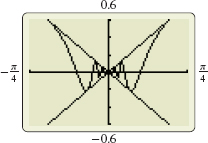EXAMPLE 1Using the Squeeze Theorem to Find a Limit
Use the Squeeze Theorem to find lim.
Solution If x\neq 0, then \sin \dfrac{1}{x} is defined. We seek two functions that “squeeze” y=x\sin \dfrac{1}{x} near 0. Since -1\leq \sin x\leq 1 for all x, we begin with the inequality \begin{equation*} \left\vert \sin \dfrac{1}{x}\right\vert \leq 1\qquad x\neq 0 \end{equation*}
Since x\neq 0 and we seek to squeeze x\sin \dfrac{1}{x}, we multiply both sides of the inequality by \vert x\vert , x\neq 0. Since \vert x\vert >0, the direction of the inequality is preserved. Note that if we multiply \left\vert \sin \dfrac{1}{x}\right\vert \leq 1 by x, we would not know whether the inequality symbol would remain the same or be reversed since we do not know whether x>0 or x\lt 0. \begin{equation*} \begin{array}{r@{\qquad}ll} |x|\left\vert \sin \dfrac{1}{x}\right\vert \leq |x| & & {\color{#0066A7}{\hbox{Multiply both sides by \(\vert x \vert >0\).}}} \\[12pt] \left\vert x\sin \dfrac{1}{x}\right\vert \leq |x| & & {\color{#0066A7}{{|a|\cdot |b| = |a\,b|}.}} \\[11pt] -\vert x\vert \leq x\sin \dfrac{1}{x}\leq |x| & & {\color{#0066A7}{\vert a\vert\,{\leq}\,b\hbox{ is equivalent to } {-b\leq a\leq b.}}} \end{array} \end{equation*}

Now use the Squeeze Theorem with f(x) = - |x|, g(x) = x\sin \dfrac{1}{x}, and h(x) = |x|. Since f(x)\leq g(x)\leq h(x) and \begin{equation*} \lim_{x\rightarrow 0}f(x)=\lim_{x\rightarrow 0}(-|x|)=0\qquad \hbox{and}\qquad \lim_{x\rightarrow 0}h(x)=\lim_{x\rightarrow 0}\vert x\vert =0 \end{equation*}
it follows that \lim_{x\rightarrow 0}g(x)=\lim_{x\rightarrow 0}\left( x\cdot \sin \frac{1}{x} \right) =0